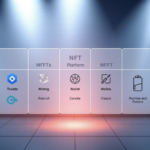Now Reading: Mastering Layer 2 Blockchain: Your Step-by-Step How-to
- 01
Mastering Layer 2 Blockchain: Your Step-by-Step How-to
Mastering Layer 2 Blockchain: Your Step-by-Step How-to
Modern digital networks face a critical challenge: balancing speed, cost, and security. Traditional systems often struggle under heavy use, leading to delays and high fees. This is where secondary solutions come into play, offering upgrades without overhauling existing infrastructure.

These enhancements act like express lanes on a highway. They handle tasks away from the main network, freeing up space and resources. By processing transactions off the primary chain, they dramatically boost efficiency while maintaining core security features.
Adoption of these frameworks has surged as user demand grows. They address bottlenecks by creating parallel pathways for data validation. This approach reduces congestion and operational costs, making decentralized systems more practical for everyday use.
Key Takeaways
- Secondary networks improve speed and lower costs for base systems
- Security remains intact through connection to original chains
- Transaction capacity increases without major protocol changes
- Off-chain processing reduces strain on primary networks
- These systems are becoming vital for mass adoption
Understanding the Blockchain Landscape
At the heart of modern technology lies a pressing problem: balancing innovation with practical performance. Core networks form the backbone of decentralized systems, acting as public ledgers that record every transaction. These foundational chains rely on consensus mechanisms to validate operations, ensuring trust without centralized control.

Blockchain Basics and the Role of the Main Chain
Ethereum exemplifies this architecture. Launched in 2015 after Vitalik Buterin’s 2013 proposal, it introduced self-executing agreements called smart contracts. As the second-largest network by market value, Ethereum processes 15-30 transactions per second. For perspective, VISA handles 1,700 TPS – a 56x difference.
Main chains like Ethereum prioritize security and decentralization. Every action requires verification across multiple nodes, creating an immutable record. This design prevents fraud but limits speed. Transactions take ~15 minutes to finalize, compared to near-instant credit card approvals.
Decentralization, Security, and the Scalability Challenge
Three pillars define these systems: decentralization, safety, and capacity. Increasing one often weakens others. For example, adding nodes boosts security but slows validation. Similarly, expanding throughput risks centralization if fewer validators handle more data.
Traditional payment networks avoid this trilemma through centralized control. Decentralized chains can’t compromise on security, creating bottlenecks. This tension highlights why secondary frameworks became essential for scaling without sacrificing core principles.
Unpacking the Need for Layer 2 Solutions
Innovation in decentralized systems faces a fundamental roadblock: balancing three competing priorities. Ethereum co-founder Vitalik Buterin identified this as the scalability trilemma – the struggle to maintain security, decentralization, and throughput simultaneously. Most networks achieve only two, creating bottlenecks during peak usage.

The Scalability Trilemma Explained
Buterin’s framework reveals why base chains struggle under pressure. When Ethereum processes 30+ transactions per second, fees spike and confirmation times lengthen. During 2021’s NFT boom, users paid $200+ for simple transfers – impractical for regular use.
Three core functions strain these systems:
- Transaction execution
- Data storage requirements
- Network-wide consensus
How Layer 2 Overcomes High Fees and Slow Transactions
Secondary frameworks tackle execution – the most resource-heavy task. By processing payments off the main network, they slash costs and wait times. A $2 transfer might cost pennies through these systems while still benefiting from Ethereum’s security.
These solutions bundle multiple actions into single verifications. This approach maintains decentralization but multiplies capacity. Developers achieve this without altering original protocols – like adding turbochargers to existing engines.
Diverse Architectures: Payment Channels, Rollups, and Sidechains
Scalability solutions come in different flavors, each addressing network congestion through unique methods. These frameworks share a common goal: moving heavy lifting away from crowded networks while preserving security guarantees.

Payment Channels and Off-Chain Transaction Efficiency
Imagine two coworkers splitting lunch costs daily. Instead of swiping cards each time, they track IOUs and settle weekly. Payment channels work similarly – users lock funds in a shared account, then exchange unlimited transactions off-chain. Only opening/closing balances hit the main network.
This approach slashes fees to near-zero. A coffee purchase becomes feasible without $3 gas charges. Channels support instant micropayments, perfect for gaming or streaming services needing split-second interactions.
Rollups Demystified: Optimistic vs. Zero-Knowledge
Rollups act like cargo ships for transactions. They pack thousands of actions into single bundles, then anchor them to the main chain. Two variants dominate:
- Optimistic: Presumes honesty but allows fraud challenges for 7 days
- Zero-knowledge: Uses math proofs to verify validity instantly
Optimistic models cost less but delay withdrawals. Zero-knowledge systems process faster but require specialized hardware. Both cut fees by 90% compared to base networks.
Sidechains offer another path – independent networks with custom rules. They connect via bridges, allowing asset transfers while handling complex computations separately. While less secure than rollups, they enable experimentation with novel consensus mechanisms.
How “Layer 2 blockchain” Enhances Efficiency and Security
Digital infrastructure breakthroughs often emerge from solving fundamental conflicts. Scaling solutions achieve this by separating execution from verification – handling transactions externally while anchoring trust to established systems.
Mechanics of Off-Chain Transaction Processing
Secondary networks act as turbocharged workbenches. They process thousands of actions externally, then submit condensed proof bundles to main networks. This approach reduces data load by 90% compared to base chains.
Smart contracts serve as automated auditors. They hold funds until receiving validity confirmations, creating financial incentives for honest behavior. This system enables instant micropayments while maintaining accountability.
Ensuring Security Through Cryptographic Proofs
Two verification methods dominate scaling solutions. Optimistic systems assume honesty but allow challenges using fault proofs. Zero-knowledge alternatives provide instant confirmation through mathematical validity proofs.
Cryptographic signatures in payment channels create tamper-evident records. These digital fingerprints let users prove transaction history during disputes. The main chain only intervenes when conflicts arise, minimizing its workload.
This architecture combines efficiency with ironclad security. By outsourcing computation while keeping verification on trusted networks, users enjoy faster speeds without sacrificing protection. The result? Systems that handle Visa-level throughput while preserving decentralized principles.
Strategies for Implementing Layer 2: A Beginner’s Guide
Choosing the right scaling framework can make or break your decentralized project. With multiple options available, developers must evaluate speed, cost, and compatibility. Let’s explore leading Ethereum scaling solutions and practical implementation strategies.
Navigating Popular Ethereum Scaling Solutions
Polygon leads with 1,000+ transactions per second at $0.01 fees – ideal for cost-sensitive applications. Its compatibility with Ethereum tools lets developers migrate existing smart contracts effortlessly.
Arbitrum’s optimistic rollups handle 40,000 TPS with two-cent fees. This network shines for DeFi projects needing high throughput without rewriting code. Base, built on Coinbase’s infrastructure, locked $300 million in three months using optimized OP Stack technology.
For NFT creators, ImmutableX offers gas-free minting and 9,000 TPS through zero-knowledge proofs. Gaming projects favor Ronin’s proof-of-authority model, delivering instant transactions under $0.005 – perfect for in-game purchases.
Step-by-Step Onboarding and Development Tips
- Identify use case requirements: transaction volume, cost limits, and security needs
- Choose networks with EVM compatibility to reuse existing smart contract logic
- Test deployments on testnets before mainnet launches
- Utilize platform-specific SDKs and documentation
Developers should prioritize networks offering detailed smart contract analytics and user-friendly dashboards. For consumer applications, select solutions with wallet integrations that match your target audience’s preferences.
Innovative Use Cases and Growing Ecosystem Benefits
Global industries are witnessing a silent revolution through advanced scaling solutions. Major corporations and startups alike now leverage these frameworks to solve real-world challenges, proving their value beyond theoretical concepts.
Practical Applications in DeFi, NFTs, and dApps
Starbucks transformed its loyalty program using Polygon’s infrastructure, slashing transaction fees by 99%. This move enabled micro-rewards for coffee purchases – impossible with traditional payment systems.
ImmutableX redefined digital collectibles through gas-free NFT minting. Artists and gamers trade assets instantly without upfront costs, expanding creative opportunities. The platform powers Web3 games handling 9,000+ transactions per second.
Ronin blockchain exemplifies specialized adoption, built exclusively for Axie Infinity. Its $0.005 fees and instant confirmations support 2 million daily active gamers. These success stories demonstrate how scaling solutions unlock new markets while improving user experiences.
As adoption grows, diverse sectors from healthcare to supply chains explore these frameworks. The ecosystem thrives by merging enterprise needs with decentralized technology’s potential – reshaping industries one transaction at a time.
FAQ
What is the primary purpose of Layer 2 solutions like rollups and sidechains?
These architectures boost scalability by handling transactions off the main chain, cutting fees and congestion. They rely on cryptographic proofs or fraud detection mechanisms to maintain security inherited from networks like Ethereum.
How do optimistic rollups differ from zero-knowledge rollups?
Optimistic rollups assume transactions are valid unless challenged, requiring a dispute period. Zero-knowledge rollups (zk-Rollups) use validity proofs to instantly verify correctness, enabling faster finality and lower latency.
Can these solutions compromise decentralization or security?
No. Platforms like Arbitrum and zkSync leverage Ethereum’s robust consensus while processing off-chain data. Security is ensured through proofs or challenges, creating trustless verification without centralization risks.
How do payment channels reduce costs for frequent transactions?
By enabling users to conduct multiple transactions off-chain—like Bitcoin’s Lightning Network—payment channels settle only the final state on the main chain, slashing fees by up to 90%.
What industries benefit most from Layer 2 adoption?
DeFi protocols (Uniswap, Aave), NFT marketplaces (OpenSea), and gaming dApps use networks like Polygon to enable microtransactions, instant trades, and complex smart contracts at scale.
Are these solutions compatible with all blockchains?
Most target Ethereum’s ecosystem, but frameworks like Cosmos SDK allow custom implementations. Projects like StarkEx support multi-chain interoperability for broader adoption.
What are leading examples of Layer 2 platforms?
Optimism and Arbitrum use optimistic rollups, while zkSync and StarkNet employ zk-Rollups. Polygon combines sidechains and rollups, offering flexibility for developers and enterprises.
How can developers start building on these networks?
Tools like Hardhat and Foundry simplify deployment. Platforms like Optimism provide grants and tutorials, while cross-chain bridges enable seamless asset transfers between layers.














